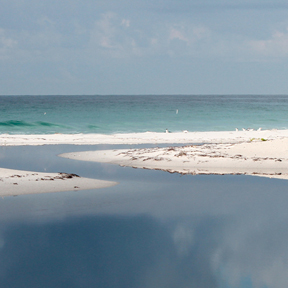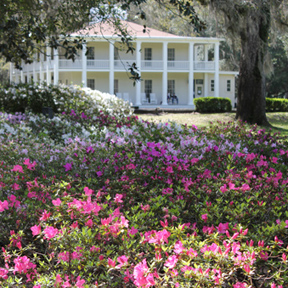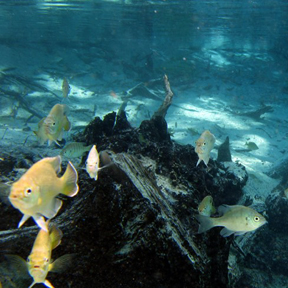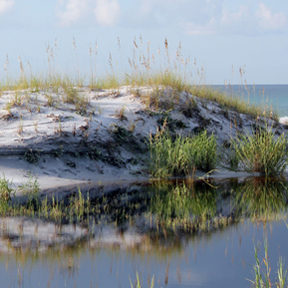Fish, hike, paddle and enjoy wildlife along the coastal dune lakes of South Walton
 Walton County is well known for its beautiful beaches and great fishing. Less known to those that have never visited the area, are the unique and scenic coastal dune lakes that dot the coastline along the area’s beach dune systems.
Walton County is well known for its beautiful beaches and great fishing. Less known to those that have never visited the area, are the unique and scenic coastal dune lakes that dot the coastline along the area’s beach dune systems.
Nestled along Scenic Highway 30A, Walton county’s coastal dune lakes are rare geological features that only occur in the Florida Panhandle, Madagascar, Australia, New Zealand and the northern Pacific coast of the United States.
Streams, groundwater seepage and rain are the sources that feed the coastal dune lakes. Storm surge creates intermittent connections to the Gulf of Mexico, called outfalls. This periodic connection empties lake water into the Gulf, and, depending on tides and weather, salt water and organisms from the Gulf flow back into the lakes.
Explore the beauty of Eden Gardens State Park
 A beautiful Northwest Florida State Park is nestled in the Point Washington area of South Walton County. Large moss covered live oaks, walking trails and panoramic views of Tucker Bayou provide a visual delight for visitors to this historic park.
A beautiful Northwest Florida State Park is nestled in the Point Washington area of South Walton County. Large moss covered live oaks, walking trails and panoramic views of Tucker Bayou provide a visual delight for visitors to this historic park.
The focal point of the 161-acre park is the two-story Wesley house boasting large white columns and wrap-around porch. Originally owned by the Wesley’s a wealthy Florida timber family, the mansion was purchased in 1963 by Lois Maxon who renovated the home and created a showplace for family heirlooms and antiques. The collection of Louis XVI furniture is the second largest in the United States.
Guided tours of the Wesley house are available hourly Thursday through Monday from 10 a.m. to 3 p.m. (including holidays).
Throughout the year, chances are you will enjoy something in bloom. Camellias in winter, azaleas in spring, roses in summer are just a few the colorful floral species you can expect to see. The Friends of Eden Gardens State Park spend countless hours maintaining and enhancing the park’s natural beauty.
A colorful journey awaits you on Econfina Creek
 Part of Florida’s Greenways and Trails, the Econfina Creek in Bay and Washington counties is many a paddlers’ favorite journey in the Florida Panhandle.
Part of Florida’s Greenways and Trails, the Econfina Creek in Bay and Washington counties is many a paddlers’ favorite journey in the Florida Panhandle.
Pack a lunch and bring your snorkel, for you are about the enjoy the paddle of a lifetime as you explore the creek and its many crystal clear springs along the popular seven-mile trip down the creek. Cabbage palms drape over the water’s edge along with blooming wildflowers scattering the banks with color during your journey in the spring and summer months. Steep, fern-covered limestone walls prevail along the second half of the paddle, where the creek slices into the ancient limestone of the Floridan Aquifer.
On a hot and humid summer’s day the creek takes on an ethereal feel as a fog layer hangs suspended in the air when the cool water meets the hot air.
The northern portions of the creek are difficult with many logjams and shallow water. Most paddlers opt to put in at the Econfina Livery as the livery offers the option of pick up and return at the take out at SR 388 bridge. They also have kayaks and canoes available for rent.
A closer look at Topsail Hill Preserve State Park
 Topsail Hill State Preserve must be seen to be appreciated. It is one of the most diverse natural eco-systems in the state, featuring wet prairies, scrub, pine flatwoods, marshes and cypress domes.
Topsail Hill State Preserve must be seen to be appreciated. It is one of the most diverse natural eco-systems in the state, featuring wet prairies, scrub, pine flatwoods, marshes and cypress domes.
The park has more than three miles of pristine beaches and five dune lakes which encompass more than 170 acres on more than 1,637 acres of park.
Now known as the “Crown jewel of the Panhandle,” the park has RV accommodations, with 156 sites and 16 rental cabins, and continues to be one of the most popular in the state. Booking is often solid for 11 months ahead.
New renovations to the park will include a new ranger station, 16 additional rental cabins, 22 more campsites, a new tram path, and a bike path around the coastal dune lakes.
Wildflowers bloom in the Point Washington State Forest
 Fall months in the Point Washington State Forest offers a diverse landscape for a hiker or biker to explore the area’s natural beauty.
Fall months in the Point Washington State Forest offers a diverse landscape for a hiker or biker to explore the area’s natural beauty.
Most of the State Forest consists of sandhill, basin swamps/titi drains, wet flatwoods, wet prairie and cypress swamps.
During the fall months, the array of wildflowers in bloom offer the explorer a colorful journey. Native flowers in bloom include wild buckweat (Eriogonum tomentosum), hairy jointweed (Polygonella basiramia), senna symeria (seymeria cassioides), goldenaster (Chrysopsis sabrella), goldenrod (Soldago tortifolia), figwort (Agalinis satacea) and blazing star (Litatris champanii) to name a few.
Several plants and animals that are listed as threatened, endangered or species of special concern exist on the Point Washington State Forest. Some of these rare species include: american kestrel (Falco sparverius), gopher tortoise, flatwoods salamander, white-topped pitcher plant (Sarracenia leucophylla) and the world’s largest population of Curtiss sandgrass (Calamovilfa curtissii).
Explore natural beauty along the Apalachicola Bluffs and Ravines Preserve’s Garden of Eden Trail
 Get on your hiking boots, grab on to your trekking poles and head out to the Garden of Eden Trail. This 3.3 mi. steephead ravine and bluff in Bristol is one of Northwest Florida’s most beautiful hikes.
Get on your hiking boots, grab on to your trekking poles and head out to the Garden of Eden Trail. This 3.3 mi. steephead ravine and bluff in Bristol is one of Northwest Florida’s most beautiful hikes.
Situated adjacent to the Apalachicola River in Bristol, Florida, the trail is located within the Apalachicola Bluffs and Ravines Preserve. Owned and managed by the Nature Conservancy, the trail is open to the public for hiking from dawn to dusk, year-round.
The Trail begins along a restored long leaf pine/wiregrass upland area. Like most of Northwest Florida, this area was once cleared by timber production years ago. In 1985, the Nature Conservancy started restoration of this sandhill area, and today it boasts an abundance of long leaf, wiregrass and turkey oak.
Soon the trail starts changing into a hardwood hammock as it descends towards a scenic steephead ravine.
Enjoy a hike along Bruce Creek in Walton County
 A great way to explore the Choctawhatchee River basin is taking a hike along Bruce Creek in Northeast Walton County. Located off of State Road 81 south of Ponce De Leon, this shallow creek runs west to east through the center of the county and eventually empties into the Choctawhatchee River.
A great way to explore the Choctawhatchee River basin is taking a hike along Bruce Creek in Northeast Walton County. Located off of State Road 81 south of Ponce De Leon, this shallow creek runs west to east through the center of the county and eventually empties into the Choctawhatchee River.
The trail is not maintained, however mostly clear and fairly easily to navigate. This area within the river basin is accessible when water levels are normal to low. If the water levels are up, the creek offers any opportunity for a pleasant kayak or canoe paddle.
A high canopy of hardwoods provide pleasant shade for most of the journey through the swamp forest. Large oaks, magnolias, red maple, hickory, black gum, tupelo and cypress tower above; fetterbush and hollies abound below the tall giants. The wetlands slope gently towards the river, boasting an abundance of saw palmetto, lichen, fungi, and moss.
Civilian Conservation Corps played major role in formation of early Florida State Parks
 In the midst of the Great Depression, the Franklin D. Roosevelt administration secured the creation of the Civilian Conservation Corps (CCC) in the spring of 1933. The program was intended to put unemployed men to work undertaking conservation work, including the restoration and recreational development of federal and state public lands.
In the midst of the Great Depression, the Franklin D. Roosevelt administration secured the creation of the Civilian Conservation Corps (CCC) in the spring of 1933. The program was intended to put unemployed men to work undertaking conservation work, including the restoration and recreational development of federal and state public lands.
During the administration of the program, CCC enrollees throughout the country were credited with renewing the nation’s decimated forests by planting an estimated three billion trees between 1933 and 1942. Throughout the U.S. more than 500,000 men participated as CCC enrollees.
Although the Florida legislature authorized creation of a state park system in 1925, it took the Depression of the 1930s and the development of federal New Deal programs to create the impetus for the formation of the Florida State Park system. Since no state funds were available for acquisitions, the early parks were acquired by donation or forfeiture for unpaid taxes.
The legend of Euchee Indian Chief Sam Story
 Could it be an Euchee (Yuchi) Indian chief named Sam Story was the earliest known conservationist in Walton county? Our history books tell us so, however some traditions handed down may be simply legends, and solidified as truth when shared through generations. So with that said, here is one story, through a collection of information, about a man named Sam Story.
Could it be an Euchee (Yuchi) Indian chief named Sam Story was the earliest known conservationist in Walton county? Our history books tell us so, however some traditions handed down may be simply legends, and solidified as truth when shared through generations. So with that said, here is one story, through a collection of information, about a man named Sam Story.
Historic documentation shows many of the earliest white settlers in Walton County were Scottish families from North and South Carolina. One of the first families it is said, the McLennan clan, came to settle in Walton in the early 1800s.
After reading about the natural beauty of Florida, Neil McLennan first brought his family to the Escambia, Blackwater river area not far from Pensacola. The family relocated from North Carolina looking for fertile land, clean air, and a place with hog and sheep ranges. However, the area was not exactly what McLennan wanted, and he went searching for something more. On a trip to Pensacola, he heard of a great trader; an Euchee Indian Chief named Sam Story, also known as Timpoochee Kinard.
